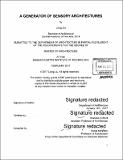A generator of sensory architectures
Author(s)
Liu, Liang, M. Arch Massachusetts Institute of Technology
DownloadFull printable version (9.095Mb)
Other Contributors
Massachusetts Institute of Technology. Department of Architecture.
Advisor
Brandon Clifford.
Terms of use
Metadata
Show full item recordAbstract
"As we have said, the majority of people consider architecture and space as an essentially visual experience. Architecture: these are buildings - and space is the emptiness contained within its walls. It is precisely where the misunderstanding resides, because space is not emptiness but rather an environment for life contained within the walls, an environment that is stimulating to the senses. It is obviously light and shadow, proportion and color, perspective and decoration, but also sounds that reverberate, surfaces that our feet walk upon, textures that we touch, temperatures that determine our degree of comfort and smells that surround and seduce us. All these things together multiply one another into an ensemble that we perceive as a whole surrounding." <Sense of Smell> Marc Crunelle. Why is it that our visual sense is so emphasized rather than the collaboration of all senses? For the convenience of visual information dissemination, we mostly perceive the outside world by seeing. And it is no doubt that the visual sense has the priority among rest of our senses. In terms of architecture, we always rely on our eyes when we are designing or experiencing architectural spaces. It is so convenient and fast to draw sketch, build Rhino model, and making renderings. But, at the same time, it's reducing the fact that architecture is such a three-dimension art should be experienced and created by the multi-sensory of our bodies. And somehow, the priority of visual sense is becoming the limitation for us to understand and pursue architecture in a broader way. Our conventional design process places emphasis on drawings and ocular representation, subverting our capacity to engage the other senses in the design process. It proposes to rouse the understanding of multi-sensory architectural design process and experience. So, in a word, by doing this thesis, I'm making the effort on challenging our ocular way to read architectures. It's challenging our conventional design methodology. And it's also challenging our existing architectural representations.
Description
Thesis: M. Arch., Massachusetts Institute of Technology, Department of Architecture, 2017. Cataloged from PDF version of thesis. Page 73 blank. Includes bibliographical references (page 72).
Date issued
2017Department
Massachusetts Institute of Technology. Department of ArchitecturePublisher
Massachusetts Institute of Technology
Keywords
Architecture.